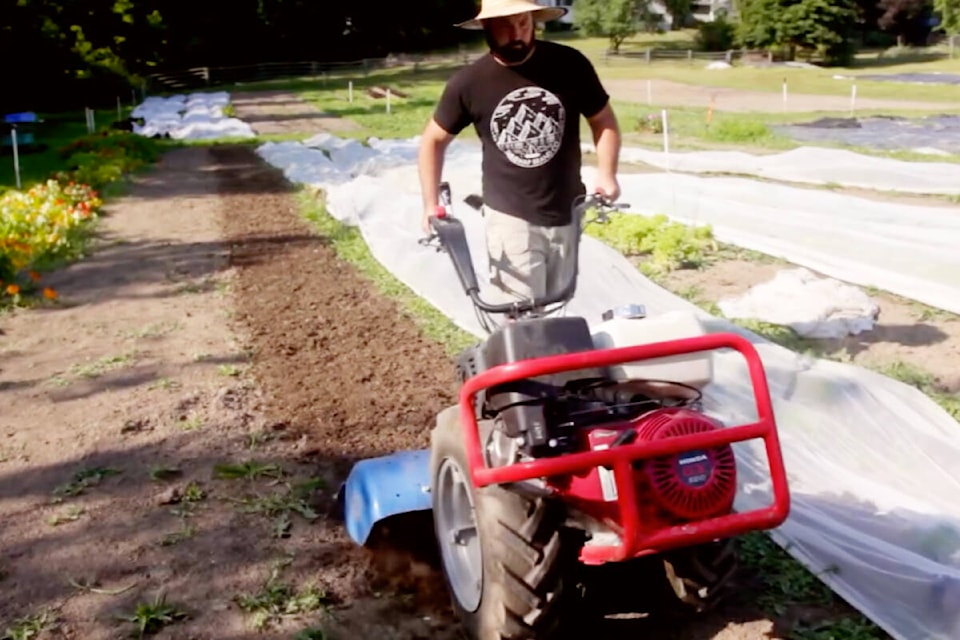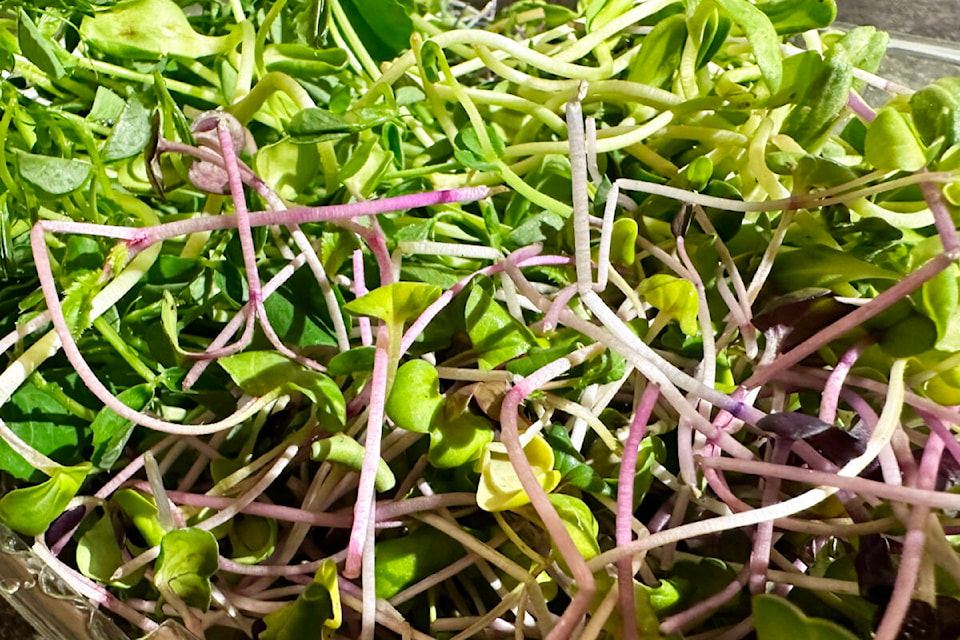More than a vitamin-rich superfood, microgreens are a crop that’s helping new generations of farmers take root in the North Okanagan-Shuswap communities.
The relatively recent trend of growing microgreens, vegetable greens (not sprouts) harvested just after their cotyledon leaves have sprouted, persists, in part, because they can be produced year-round and take relatively little time to produce, and yield high nutritional value.
“Depending on which plant you’re talking about, some plants can be 20 times the amount of nutrition, especially vitamins, per pound, compared to the full-grown vegetable. It’s mind-blowing,” said Jean-Francois Chaumont, the owner/operator of Sacred Earth Eco-Farm in Salmon Arm.
A University of Maryland study found microgreens contained four to 40 times more than their vegetable counterparts.
Chaumont and his family started Sacred Earth in 2017, and currently provide certified organic microgreens and salad greens to grocery stores and restaurants in the Shuswap. He said they’ll soon be selling microgreens through the online store of Mara’s Wild Flight Farm.
Thursday, Feb. 8, was a harvesting day for Chaumont, who said his microgreens would be available in stores the next day.
“We have two deliveries a week, so we harvest twice a week, so the produce is no more than three days old maximum,” said Chaumont, explaining a benefit to buying locally grown food. “Transportation is where you lose most of your nutrition in the plant, because the longer that it has lived without being in the ground, the more it loses its nutrition… it will keep the minerals pretty good, but the vitamins will diminish over time.”
Microgreens are grown indoors, typically on shelves, so they don’t require a lot of space.
“It’s pretty easy to scale and it’s decently profitable,” said Chaumont, adding it helps to be in or near larger urban markets like Salmon Arm. Though there are other microgreen growers/competitors in the region, Chaumont views this as a plus for the building of resilient, food-secure communities.
“The more farmers we have, the more available produce we have locally, the more resilient we are…,” said Chaumont. “And you know what, it’s just less gas for transportation… it’s a little more money going directly to the farmer and it employs people in the town and the area. I’m happy with it.”
Microgreen producer Seth Armbruster, the owner/operator of Sweet Haven Farms in Cherryville, also views “competition” as a strength for the region.
“It helps to spread more knowledge on microgreens and it reaches a wider range of people… I don’t think it’s really a bad thing,” said Armbruster, adding he’s heard from other growers with the same mindset, the more people growing, the better.
“If anything it’s just more people getting good food… If it ever turned into a thing where every city has it’s own grower, which it seems like it’s turning into, I think that’s great too because it just means more sustainable agriculture, people can get food that’s completely local, not shipped from the Lower Mainland or who knows where, or these big mega-corporations. Small farmers actually making a living and being able to support themselves in their local area without having to ship food across the country or whatever.”
Armbruster said he grew up on a hobby farm in the Coldstream area. After high school he was looking for something to do that, ideally, involved farming. He found the guidance he was looking for on YouTube, particularly videos by farmer, author and consultant Curtis Stone, on how one can make a living on less than a quarter-acre of land with microgreens – “basically more high intensity crops.
“I found that interesting – It was the winter time, I was kind of bored, so I just started there, in the house actually, with a couple of trays – and that moved into the basement,” said Armbruster. “We grew to like 100 trays and I realized that’s not great to have this in the basement. So we built a shop and facility and we have an operation in about 1,000 square feet.”
Armbruster said his foray into microgreens began with a number of crop failures, as he learned to adjust things such as seed density and moisture so as to prevent mould. Regarding those failures, he called microgreens a “less risky crop to grow, because if you’re growing something that takes the whole year and you have crop failure, you’re kind of stuck and that can be a bit of an issue.
“This way, if you have crop failure, it’s one week and then OK, we’ll try again for next week, because it’s a weekly basis, every week you have a new crop, and you can really dial in the health of your crop and get a really solid grasp on how to do it in a short amount of time.”

These factors, explained Chaumont, are part of what make microgreens an attractive crop for new generations of farmers.
“A lot of young people are now getting into farming, and it’s not going to be with tractors, with big machines and big buildings and thousands of acres because land prices, house prices, everything is very expensive,” said Chaumont, adding he uses nothing but hand tools on his farm, including a two-wheel, walk-behind tractor. “Everything is just hand work, because this is the easiest way to get into it. It’s hard, but it’s easier and it’s possible to do it that way. And you can scale up to a few acres and do intensive farming, so a quarter of an acre, you can produce $25,000 to $30,000 easy on that.”
On the topic of producing local, Chaumont, who came to Salmon Arm from Quebec, said at some point he would like to get a farmer’s co-operative started. Another goal is to grow his farm to further bolster the community’s resiliency to food insecurity.
“I’d like to grow this farm so that I can feed the needs of as many grocery stores around here as possible, so that Salmon Arm can depend on their local growers for hopefully the majority of the food in the grocery store, at least in the produce aisle…,” said Chaumont. “I think that’s kind of something everybody would like. We’re trying to do that. It takes a lot of years to build the experience and to build the capital to build a farm up to that point, but every year I try to build towards that goal.”
Visit Sacred Earth Eco-Farm on Facebook to learn more about the farm. For more information Sweet Haven Farms, visit bestgreens.ca.
